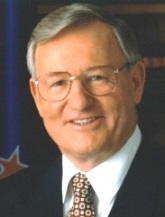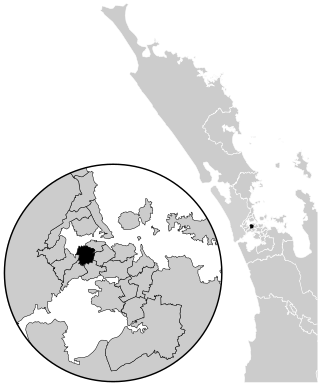Activities and achievements
| External image | |
|---|---|
Following WEL's foundation in March 1975 its members immediately became active lobbying and formulating policy. In that year WEL achieved the following:
- Lobbied MPs on proposed legislation (1975 Hospital Amendment Bill) which would restrict access to safe abortion to public hospitals
- Monitored and responded to political statements inside and outside parliament
- Compiled a list of women qualified and able to sit on government appointed bodies
- Set up study groups to formulate WEL policies on women's health, education, employment and legal rights
- Arranged four lunches with party leaders before the election. The lunch with Robert Muldoon, the then Leader of the Opposition, was controversial as he did not think women's opinions and questions were worthy of his time
- Surveyed all candidates standing for parliament in the November general election [12]
- Presented a survey of the elderly to the Minister of Social Welfare, Norman King, in May 1975 [13]
National elections
WEL ran the following campaigns for various general elections.
1975
WEL conducted a survey of political candidates standing for election in November. Interviewing for the survey began in August 1975 with face-to-face interviews conducted by WEL members working in teams of two. The survey explored candidates’ attitudes to women's issues and the support they would give to addressing them. The questionnaire had six sections: discrimination, employment, childcare, health, education and awareness of issues facing women. Robert Muldoon had to be persuaded to allow National Party candidates to participate, and many candidates were frightened of being interviewed by politically minded women and having their answers scored. Responses were scored to provide a guide for voters: a score of above 6 recorded the interviewee as either a feminist activist or liar; a minus score was given for views unfavourable to women. The highest score was obtained by Cathy Wilson, the Values Party co-leader and the lowest by Henry May, the Minister of Internal Affairs. Results were released in October 1975 and distributed widely through meetings and the media. [14]
The survey showed how little politicians and political parties considered women's issues with the result that the parties began to formulate policies on women and families. In spite of this four women were elected to parliament, including Marilyn Waring and Colleen Dewe. [15]
1978
For the 1978 general election, a shorter simpler questionnaire was used for candidates and included questions on issues pertinent to each branch. [15] Only four women were elected.
1981
In the 1981 election WEL changed tactics producing a pamphlet listing the biographical details and attitudes of women candidates to fertility control, abortion and childcare. The number of women MPs doubled to eight. Three of the women elected had been influential in WEL: Ruth Richardson, Marilyn Waring and Margaret Shields. [15]
1984
| External image | |
|---|---|
WEL's election pamphlet for the 1984 election emphasised the contribution of women to parliament. The number of women MPs elected totalled twelve. [16]
1987
In the 1987 election, WEL focussed on making women aware of the major issues facing them: jobs, environment, Treaty of Waitangi, women in parliament, pornography, proportional representation, equal educational and employment opportunities, women's health and fertility control, dependency care and peace. Fourteen women were elected in 1987. [17]
1990s
In the 1990 election, sixteen women were elected; after the 1993 election there were 21 women MPs making their proportion 20%.
WEL supported the change from a first-past-the-post electoral system to mixed-member proportional representation (MMP), which would give more opportunity for women and Māori to be elected to parliament as party list candidates. [18] In the first MMP election in 1996 the number of women increased sharply to 35. [19] Following the election WEL continued its commitment to equity and monitoring policy promises and legislation. [20]
Local government elections
In the October 1977 local government elections WEL encouraged women to take an interest in the elections and to make sure their names were on the electoral rolls. Over the years WEL did a lot of education to ensure women got their names on the electoral rolls and ran workshops for women wanting to stand for election to councils. [21] [22] The Wellington branch launched a booklet How to Take Part in Local Government, which explained what local government was and its relevance to women's lives. [23] [24] As a result, there was much greater acceptance of the need for women to be represented in local government and more women were elected to councils. [25] In Here I Stand, published in time for the 1983 local government elections, women in local government outlined their experiences. [23] [26] In the 1986 elections a number of WEL members were successful candidates. [27]
Between 1974 and 1980, the number of women in local government doubled. In 1983 the number of women mayors increased from six to twelve. [28]
Women’s appointments
WEL, the National Council of Women and the Committee on Women produced a list of 200 names in 1978 of women qualified for appointment to statutory bodies. The Prime Minister Robert Muldoon responded by saying that balanced women were needed on boards, not “beady-eyed ladies who scream slogans”. There were 600 boards and of WEL's list of 100 names fewer than 5 had been appointed. The lists covered a cross section of women and WEL's stated that they were hardly “militant feminists”. [29] Two Wellington women responded to Muldoon's comments by printing T-shirts with the slogans ‘Beady-eyed Ladies Inc.’ and ‘Slogans by request’. [30]
As a result of the work of WEL, and other organisations, a Women's Appointment File was produced by the Ministry for Women's Affairs; this became a nominations service administered by the Ministry for Women. [31]
Policy
In July 1978 WEL published its policy manifesto A New Look: a WEL view of some changes for New Zealand. [32] Its purpose was to inform candidates for the 1978 general election and the general public on issues for New Zealand women. [33]
Proposals for change in the manifesto covered seven areas:
- Early childhood services
- Education
- Employment
- Health
- Law
- Social welfare
- Town planning [34]
The policy areas were further developed and updated during the 1980s and 1990s. In the 1980s, policies covered childcare services, education, employment, health, law, local government, finance, pornography, international and miscellaneous. By 1993 policies covered childcare services, education, employment, health, law, local government, social welfare, pornography. [35]
Advocacy
During the 1980s and 1990s WEL was active nationally and at branch level advocating, lobbying and protesting on a number of issues of concern to women:
- the 1981 Springbok rugby tour
- the Working Women's Charter
- matrimonial property
- contraception, sterilisation and abortion
- rape
- homosexuality
- the electoral system
- promotion of a Ministry of Women's Affairs (which was established in 1984)
- promotion of a Human Rights Commission
- promotion of a nuclear-free New Zealand [36]
- the 1991 budget, known as the Mother of all Budgets. WEL was concerned at cuts to the welfare budget and the absence of any analysis regarding the effect of the budget on women's lives. Particular concerns were the risk of a poverty trap for women and children, loss of economic independence, and the future social implications of the budget [37]
WEL's advocacy contributed to legislative or other outcomes that addressed women's concerns. [38]













